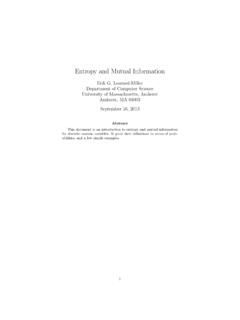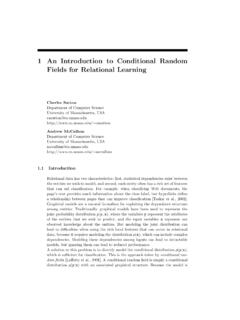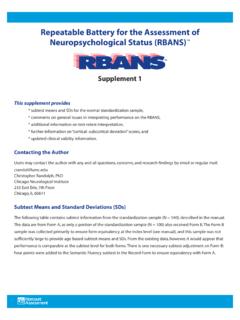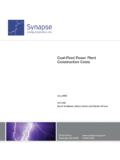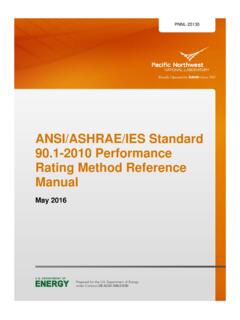Transcription of Conditional Random Fields: An Introduction - UMass Amherst
1 Conditional Random Fields: An Introduction . Hanna M. Wallach February 24, 2004. 1 Labeling Sequential Data The task of assigning label sequences to a set of observation sequences arises in many fields, including bioinformatics, computational linguistics and speech recognition [6, 9, 12]. For example, consider the natural language processing task of labeling the words in a sentence with their corresponding part-of-speech (POS) tags. In this task, each word is labeled with a tag indicating its appro- priate part of speech, resulting in annotated text, such as: (1) [PRP He] [VBZ reckons] [DT the] [JJ current] [NN account] [NN.]
2 Deficit] [MD will] [VB narrow] [TO to] [RB only] [# #] [CD ] [CD. billion] [IN in] [NNP September] [..]. Labeling sentences in this way is a useful preprocessing step for higher natural language processing tasks: POS tags augment the information contained within words alone by explicitly indicating some of the structure inherent in language. One of the most common methods for performing such labeling and segmen- tation tasks is that of employing hidden Markov models [13] (HMMs) or proba- bilistic finite-state automata to identify the most likely sequence of labels for the words in any given sentence.
3 HMMs are a form of generative model, that defines a joint probability distribution p(X, Y ) where X and Y are Random variables respectively ranging over observation sequences and their corresponding label sequences. In order to define a joint distribution of this nature, generative mod- els must enumerate all possible observation sequences a task which, for most domains, is intractable unless observation elements are represented as isolated units, independent from the other elements in an observation sequence. More precisely, the observation element at any given instant in time may only directly University of Pennsylvania CIS Technical Report MS-CIS-04-21.
4 1. depend on the state, or label, at that time. This is an appropriate assumption for a few simple data sets, however most real-world observation sequences are best represented in terms of multiple interacting features and long-range depen- dencies between observation elements. This representation issue is one of the most fundamental problems when labeling sequential data. Clearly, a model that supports tractable inference is necessary, however a model that represents the data without making unwar- ranted independence assumptions is also desirable. One way of satisfying both these criteria is to use a model that defines a Conditional probability p(Y |x) over label sequences given a particular observation sequence x, rather than a joint distribution over both label and observation sequences.
5 Conditional models are used to label a novel observation sequence x? by selecting the label sequence y ? that maximizes the Conditional probability p(y ? |x? ). The Conditional nature of such models means that no effort is wasted on modeling the observations, and one is free from having to make unwarranted independence assumptions about these sequences; arbitrary attributes of the observation data may be captured by the model, without the modeler having to worry about how these attributes are related. Conditional Random fields [8] (CRFs) are a probabilistic framework for label- ing and segmenting sequential data, based on the Conditional approach described in the previous paragraph.
6 A CRF is a form of undirected graphical model that defines a single log-linear distribution over label sequences given a particular observation sequence. The primary advantage of CRFs over hidden Markov models is their Conditional nature, resulting in the relaxation of the indepen- dence assumptions required by HMMs in order to ensure tractable inference. Additionally, CRFs avoid the label bias problem [8], a weakness exhibited by maximum entropy Markov models [9] (MEMMs) and other Conditional Markov models based on directed graphical models. CRFs outperform both MEMMs and HMMs on a number of real-world sequence labeling tasks [8, 11, 15].
7 2 Undirected Graphical Models A Conditional Random field may be viewed as an undirected graphical model, or Markov Random field [3], globally conditioned on X, the Random variable representing observation sequences. Formally, we define G = (V, E) to be an undirected graph such that there is a node v V corresponding to each of the Random variables representing an element Yv of Y . If each Random variable Yv obeys the Markov property with respect to G, then (Y , X) is a Conditional Random field. In theory the structure of graph G may be arbitrary, provided it represents the Conditional independencies in the label sequences being mod- eled.
8 However, when modeling sequences, the simplest and most common graph structure encountered is that in which the nodes corresponding to elements of 2. Y form a simple first-order chain, as illustrated in Figure 1. Y1 Y2 Y3 Yn 1 Yn .. X = X1 , .. , Xn 1 , Xn Figure 1: Graphical structure of a chain-structured CRFs for sequences. The variables corresponding to unshaded nodes are not generated by the model. Potential Functions The graphical structure of a Conditional Random field may be used to factorize the joint distribution over elements Yv of Y into a normalized product of strictly positive, real-valued potential functions, derived from the notion of Conditional Each potential function operates on a subset of the Random variables represented by vertices in G.
9 According to the definition of Conditional independence for undirected graphical models, the absence of an edge between two vertices in G implies that the Random variables represented by these vertices are conditionally independent given all other Random variables in the model. The potential functions must therefore ensure that it is possible to factorize the joint probability such that conditionally independent Random variables do not appear in the same potential function. The easiest way to fulfill this requirement is to require each potential function to operate on a set of Random variables whose corresponding vertices form a maximal clique within G.
10 This ensures that no potential function refers to any pair of Random variables whose vertices are not directly connected and, if two vertices appear together in a clique this relationship is made explicit. In the case of a chain-structured CRF, such as that depicted in Figure 1, each potential function will operate on pairs of adjacent label variables Yi and Yi+1 . It is worth noting that an isolated potential function does not have a direct probabilistic interpretation, but instead represents constraints on the configu- rations of the Random variables on which the function is defined.




